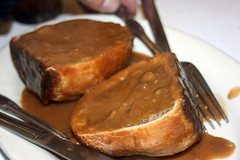 C.C. Glenn A kasha knish at B & H Dairy & Vegetarian, 127 Second Avenue.
C.C. Glenn A kasha knish at B & H Dairy & Vegetarian, 127 Second Avenue.Traditionalists argue whether a knish should be round or square, baked or fried, but what about blueberry or chocolate cheese? Is a knish truly a knish if it’s not a savory potato snack?
In search of a culinary adventure on Tuesday night, a couple dozen knish veterans, newbies and plain epicurious folks met in Tompkins Square Park to embark on NYC Food Crawl’s newest installment – a quest for the perfect knish.
Like a giddy camp counselor, Amanda Gilmore organized teams with captains, doled out maps of knish stops and gave out tips to crawlers while standing atop a gate post. “It’s all about going at your own pace,” said Ms. Gilmore, one of the founders of NYC Food Crawl. “Patience is generally key.”
Read more…
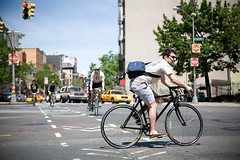 Emily Anne Epstein By one analysis, the redesigned bike lanes across the city have resulted in safer conditions for cyclists, motorists and pedestrians.
Emily Anne Epstein By one analysis, the redesigned bike lanes across the city have resulted in safer conditions for cyclists, motorists and pedestrians.Amid all the opinions raised for and against the city’s new street designs, Gaetano Puglio, manager of the Bean Café, minces no words: he doesn’t like them. Especially not the one in front of the café on First Avenue at East Third Street, the site of a collision on Labor Day.
Around 1:30 a.m. on Sept. 5, a Jeep Cherokee SUV heading west on Third Street tried to turn onto First and collided with a northbound taxi. The cab veered across the First Avenue bike lane and leapt the sidewalk, injuring five people, crushing a bicycle, and taking out the Bean’s front window. One bystander was injured critically and needed surgery at Bellevue. The collision remains under investigation and neither driver has been charged.
Like many observers, Mr. Puglio wondered if last summer’s redesign of the traffic lanes on First Avenue was a contributing factor. The redesign shifted the western parking lane inward to create a protected (“Copenhagenized”) bike lane and reserved the easternmost lane for buses. Mr. Puglio said that he always viewed the previous design – with a row of parked cars abutting the curb – as “a barrier to any kind of accident.”
But an independent analysis by the city’s former traffic commissioner shows that when lanes were redesigned in other parts of the city, the result was safer conditions for drivers, cyclists and pedestrians.
Read more…
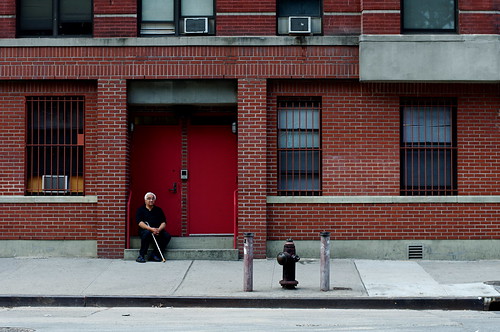 Sarah Tung
Sarah TungGood morning, East Village.
EV Grieve has an informative post about some of the memorials that are planned for Michael Shenker, the homesteader and longtime neighborhood activist who died Saturday. Later today, we’ll feature a post by NYU Journalism’s Dyan Neary, who offers a personal perspective on Mr. Shenker.
In other neighborhood news, Grieve also describes a noise dispute at a restaurant that has escalated into a lawsuit. Second Ave. Sagas has a post about this morning’s MTA meeting. And, while a little west of us, this post from Jeremiah’s Vanishing New York is worth checking out because it explores what might be “the perfect, ‘undiscovered’ New York street.”
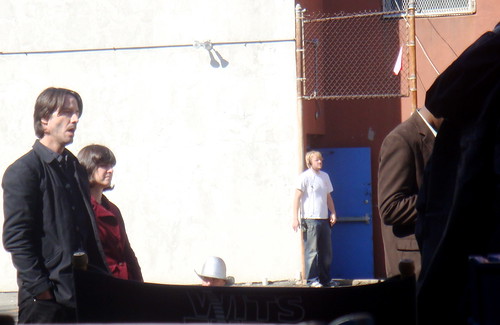 Sophie Hoeller Keanu Reeves on the set of “Generation Um…” at 11th Street and Avenue A this morning.
Sophie Hoeller Keanu Reeves on the set of “Generation Um…” at 11th Street and Avenue A this morning.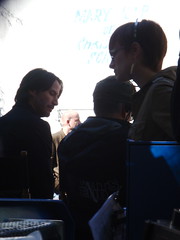 Sophie Hoeller Mr. Reeves signs an autograph (top) and in between takes.
Sophie Hoeller Mr. Reeves signs an autograph (top) and in between takes.Hula-hoops, cowboy hats, denim jackets and glitter filled a courtyard at 11th Street and Avenue A this morning. Dozens of extras were in the midst of filming a “flash mob” scene — a random assembly of people performing a planned bizarre act — for “Generation Um…” a new movie starring Keanu Reeves.
Unfazed by the colorful scene in front of him, the star was on site, looking bored between takes. He channeled his “Matrix” character, Neo, by wearing black from head-to-toe.
While getting touched up by hair and makeup, Mr. Reeves gave an autograph to an excited fan named Elias.
The indie drama follows John (Reeves’ character’s unconfirmed name) and two friends (played by actresses Bojana Novkovic and Adelaide Clemens) through “a world of sex and drugs…and chaos,” according to Cinemablend.com. The film is being made by Voltage Pictures, the studio that produced “The Hurt Locker.”
The flick has been filming in the East Village for the past two days, at locales such as AlphaBet Café. A crewmember confirmed that this would be their last day at this location. The movie, which is set in LA, has also been filming in Greenpoint, Brooklyn.
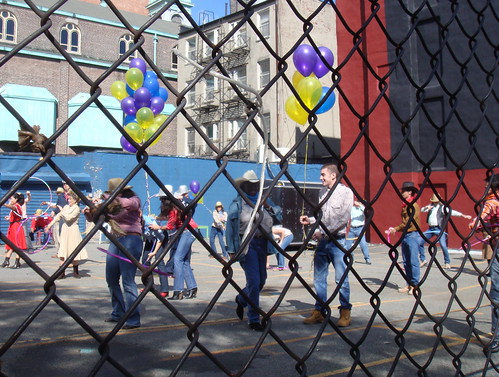 Sophie Hoeller The scene being filmed this morning depicted a “flash mob.”
Sophie Hoeller The scene being filmed this morning depicted a “flash mob.”
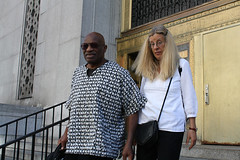 Maya Millett Trudy Silver and Bruce Morris, owners of the 5C Cultural Center, at State Supreme Court earlier today.
Maya Millett Trudy Silver and Bruce Morris, owners of the 5C Cultural Center, at State Supreme Court earlier today.A State Supreme Court justice today postponed the eviction of a nonprofit East Village arts center, which has been locked in a dispute with its co-op board for the past 15 years.
The disagreement, between the 5C Cultural Center, a nonprofit devoted to promoting jazz and the arts, and the co-op board at 702 East Fifth Street, revolves around whether the center broke a series of lease agreements regarding building repairs and music performances.
The board initiated eviction proceedings in April but earlier today Justice Saliann Scarpulla asked the two sides to try to negotiate a settlement out of court before moving forward with the eviction process.
Read more…
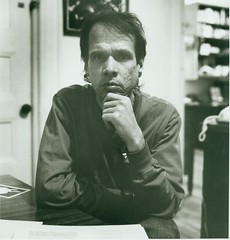 Courtesy of The Allen Ginsberg Trust Arthur Russell began collaborating with Allen Ginsberg in the 1970s with Mr. Ginsberg often reading his poetry over Mr. Russell’s instrumentals. The new track was recorded in 1977.
Courtesy of The Allen Ginsberg Trust Arthur Russell began collaborating with Allen Ginsberg in the 1970s with Mr. Ginsberg often reading his poetry over Mr. Russell’s instrumentals. The new track was recorded in 1977.In 2003, Audika Records founder Steve Knutson was digging through a Long Island City storage-facility when he struck tarnished, cassette-tape gold. The space held the archives of late East Village avant-garde composer Arthur Russell, and Knutson had found, albeit in horrible condition, “Ballad of the Lights,” a five-minute 1977 collaboration between Russell and the poet Allen Ginsberg.
Now, an individual record release will highlight the work of the two East Village cultural icons for the first time. The track, which will be released Oct. 19 was recorded in New York with Mr. Russell’s band The Flying Hearts, and Mr. Ginsberg on vocals. The track will be available on 10-inch vinyl via Japanese label Press Pop as well as digitally on iTunes via Audika Records.
Read more…
 Ben Chislett
Ben ChislettGood morning, East Village.
We’ve written quite a bit about the effects of recently installed bike lanes in the East Village. Neighborhoodr has a link to an interview with Paul Steely White, executive director of Transportation Alternatives, who talks about biking in the city.
We’re still collecting your stories about bedbugs and wanted to make sure that you saw this piece from Fox New York, which is a solid roundup of bedbug do’s and don’ts.
As a hub of the Hare Krishna Movement in America, the East Village is a special place for followers of the Hindu sect.
But a small number of followers, calling themselves the Iskcon Revival Movement, splintered from the more mainstream religion and established their own temple on St. Marks Place in 1999, only to lose the lease last year.
Now, with nowhere else to go to practice their religion, Vani and Brahmabuta-Das Wulfhoop operate a makeshift temple inside their East Village apartment.
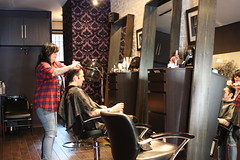 Helen Zhang Alx Alvarez is a stylist at Salon 13, at 212 Avenue B, one of several salons in the East Village that offers customers wine or beer while they wait.
Helen Zhang Alx Alvarez is a stylist at Salon 13, at 212 Avenue B, one of several salons in the East Village that offers customers wine or beer while they wait.I am finally sitting in the hairdresser’s chair, after nervously picking off most of my blue nail polish. My anxiety has been building for about two days since I made my annual appointment to cut my tailbone-length locks. In the past too many too-generous inches were chopped off without warning, so it’s hard to keep my cool once those pointed scissors come at me.
But stylist Alx Alvarez at Salon 13, at 212 Avenue B, assures me that she had been cutting hair for 20 years, styling the likes of Tommy Lee and Kate Hudson. Despite the fact that she was slugging down a 40 of Yuengling beer, I decided to trust her. To help me relax, she offered me a Coors Light.
Read more…
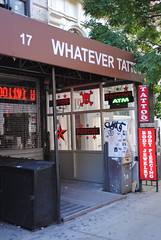 Tania Barnes The owners of Whatever Tattoos, at 17 St. Marks Place, installed new, energy-efficient bulbs in April.
Tania Barnes The owners of Whatever Tattoos, at 17 St. Marks Place, installed new, energy-efficient bulbs in April.A push by Con Edison to reduce energy consumption across the city is placing a special emphasis on the East Village.
The Avenue A Project is a program sponsored by the utility that offers local businesses free energy-efficient bulbs and other upgrades to reduce power usage. But, according to Con Ed officials, the response so far has been less than stellar.
In 2008, Con Ed asked energy consultants with Comverge Inc. to help reduce power consumption in the neighborhood by about 5 megawatts by 2012. That’s roughly equivalent to the energy that would be used if a 60-watt incandescent light bulb were placed in every seat at the New Meadowlands Stadium.
Despite such inducements as the lightbulbs and upgrades to heating and cooling systems, local businesses have mostly deflected the overtures of consultants. After two years, Comverge has managed to shave off 1.4 megawatts of power usage in the area.
Washington Teran, a consultant with Comverge, attributed the unenthusiastic response to mistrust by some business owners.
“It’s a lot of rejection,” Mr. Teran said, describing his efforts to canvass the neighborhood. “People think it’s too good to be true.”
Read more…
 Gloria Chung
Gloria ChungGood morning, East Village.
Here’s a quick look at a handful of pieces that we’re reading today from around the blogosphere.
Eater and EV Grieve have more on the closing of the “world’s largest paint party” at Webster Hall Saturday night. For history buffs, Ephemeral New York has a worthwhile post looking at a rediscovered chronicle of East Village history from the 1960s. And over at Jeremiah’s Vanishing New York, there’s a snapshot of the lunch crowd at McSorley’s.
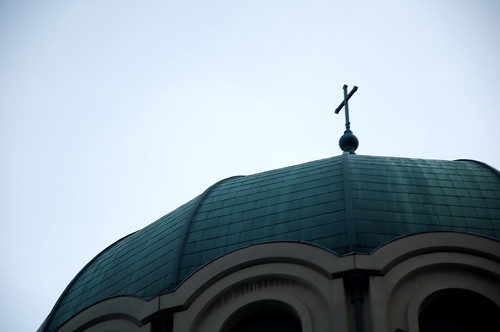 Sarah Tung
Sarah TungJust before the weekend, we posted a story about the debate over granting a landmark designation to a Russian Orthodox church on Second Street.
The piece was also referenced on nonconforminguse.com, a blog focused on land use issues.
And here at The Local, one reader, Isaac Bass, noted that the landmark dispute is “an issue that wasn’t black and white and had many facets. It left me pondering the merits of both sides of the argument and how it may be resolved in a so-called win-win way.”
We’d like to hear your thoughts about landmark designations and if you think there are any solutions that could be, as Mr. Bass noted, win-win.
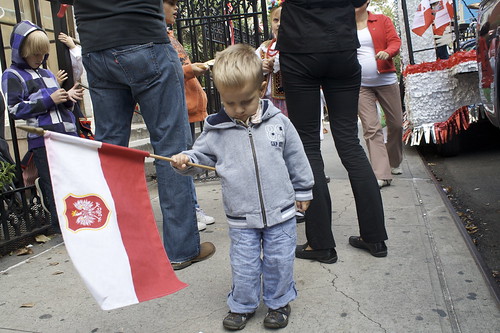 Beth Stebner A young spectator flies the Polish flag on Pulaski Day at St. Stanislaus Church.
Beth Stebner A young spectator flies the Polish flag on Pulaski Day at St. Stanislaus Church.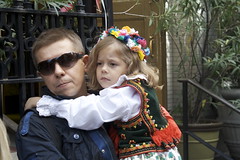 Beth Stebner From top: Miss Polonia Manhattan 2010 poses with the marshal of St. Stanislaus. Father and daughter wait for the celebration to begin.
Beth Stebner From top: Miss Polonia Manhattan 2010 poses with the marshal of St. Stanislaus. Father and daughter wait for the celebration to begin.Though old churches punctuate several East Village streets, few are so consistently busy or cause as much sidewalk spillover from residents deviating their walking paths as St. Stanislaus on East Seventh Street near First Avenue.
Sunday marked the 73rd annual Pulaski Day Parade, a celebration of New York’s Polish-American community.
St. Stanislaus hosted one float – a red and white vehicle accommodating a four-piece band. Children wore traditional Krakowiaki garments – dresses and vests in vibrant, saturated colors. Many of the youngest spectators grew impatient waiting for the departure of the float, which this year brought up the tail end of the parade.
“I think the float is great,” said 2010 Miss Polonia Manhattan, Bernadette Deron. “It really represents Polonia.”
This post has been changed to correct an error. The original version misidentified the current holder of the Miss Polonia Manhattan crown.
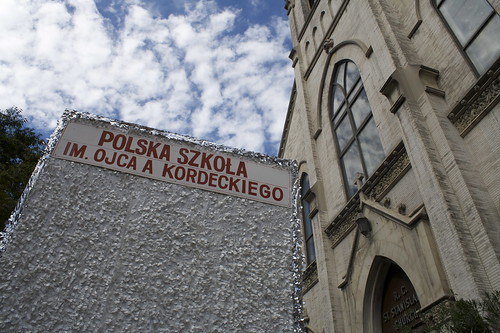 Beth Stebner A brilliant, blue October sky formed the backdrop for the parade. This year’s theme was “Poland and America: Perfect Together.”
Beth Stebner A brilliant, blue October sky formed the backdrop for the parade. This year’s theme was “Poland and America: Perfect Together.”
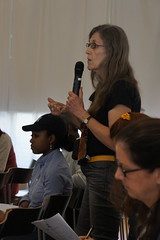 Stephanie Butnick Longtime East Village resident and community gardener Carolyn Ratcliffe speaking during the meeting.
Stephanie Butnick Longtime East Village resident and community gardener Carolyn Ratcliffe speaking during the meeting.East Village community gardeners attended a town hall meeting Saturday to express their concern that that recently revised rules governing community gardens don’t do enough to protect the green spaces from the threat of developers.
“This puts gardens in jeopardy,” Charles Krezell, a gardener who attended the meeting, said of the new rules. “We want all gardens protected for as long as they’re standing.”
In an interview before the meeting, Mr. Krezell, of the De Colores Community Yard on East Eighth Street, between Avenues B and C, said that many gardeners are worried that the new regulations don’t grant sufficient legislative protection to community gardens.
Indeed, some worry that East Village gardens may especially be at risk as area real estate continues to lure developers. Community gardeners fear that the wording of the new rules may leave gardens vulnerable.
Read more…
 Gloria Chung
Gloria ChungGood morning, East Village.
A few interesting reads from the neighborhood over the weekend.
EVGrieve offers some memories of homesteader Michael Shenker and also has photos of an event billed as “the largest paint party in the world” at Webster Hall Saturday.
Neighborhoodr presents a video assessment of how people use — or don’t use — bike lanes. This column on bike culture is worth checking out over at The Villager.
After spending part of the past week in the East Village, the cast and crew of “Gossip Girl” have moved a little bit farther south, according to Bowery Boogie.
And slightly west of our neighborhood, the Washington Square News reports on a vigil for young suicide victims who were bullied because of their sexual orientation.
The Landmarks Preservation Commission recently announced that it has issued a landmark designation for Eleventh Street Methodist Episcopal Chapel on 11th Street between Avenues A and B. Still unresolved is the status of a proposal to extend a similar designation to the Russian Orthodox Cathedral of the Holy Virgin Protection on Second Street near Second Avenue, a move so far opposed by church officials. NYU Journalism’s Gabriella Bass and Amir Shoucri report on the debate over the merits of “landmarking.”
 Gloria Chung The Ukrainian East Village Restaurant, 140 Second Avenue.
Gloria Chung The Ukrainian East Village Restaurant, 140 Second Avenue.The Ukrainian East Village Restaurant at 140 Second Avenue between St. Marks Place and Ninth Street is quite possibly the least welcoming restaurant in the hyperbolically friendly Lower East Side. My office sits across the street, and I had been there a year before I made bold last week to open the outer doors under a canopy advertising “Ukrainian National Home,” which appears to be the name of the restaurant, though it is not; pass through an empty lobby into the interior of the building; round a corner, and open a second set of doors. It was lunch time, and the restaurant looked like the grill room of a public golf course in February — low ceiling, blonde wood paneling, too-bright lighting, oilcloth-covered tables with glass tops and, of course, scarcely any customers.
Unlike the Chinese-Mingrelian tapioca bars and whatnot which dot the Lower East Side, the Ukrainian East Village Restaurant does not need to impress. It has always been there, and probably always will be. My lunchtime companion, Eyza Kurowyckyj — think of “quart of whiskey,” she says helpfully — was born on Sixth Street between First and Second Avenues in 1957, long before the first cut-rate Bengali place had arrived. Eyza says that she never knew a time when Ukie Nash, as she and the entire neighborhood called it after the name on the canopy, didn’t sit there at the end of its blank hallway, and when her friends and family members didn’t go to the giant catering hall upstairs for weddings and galas and balls. But Eyza hadn’t eaten there recently — possibly for fear that the cholesterol would kill her.
Read more…
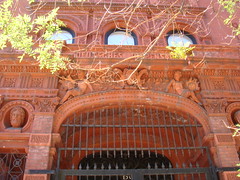 Sophie Hoeller The Deutsches Dispensary, Third Avenue and St. Marks, an enduring icon of the East Village’s history as “Little Germany.”
Sophie Hoeller The Deutsches Dispensary, Third Avenue and St. Marks, an enduring icon of the East Village’s history as “Little Germany.”Last Friday, at the start of the first weekend of Oktoberfest, we wrote about the East Village’s former notoriety as “Little Germany,” an enclave for German immigrants in the 19th century.
As the celebration of German culture comes to close this weekend, the answer to one question remains elusive: What happened to the German community in the East Village?
Some historians — and at least one reader — link Little Germany’s decline to the General Slocum disaster in 1904, when a chartered cruise boat carrying members of the St. Mark’s Evangelical Lutheran Church to a picnic, caught fire in the East River, killing more than 1,000 people, including many inhabitants of Little Germany.
A memorial of the General Slocum disaster can be found in Tompkins Square Park, where a small fountain reminds us of the Germans who lost their lives.
However, author William Grimes said that the decline was due more to the classic immigrant pattern of “succeed and disperse,” in which immigrants prospered and moved out of the immediate neighborhood. Many successful Germans moved to 86th Street, creating Yorkville, another German enclave of which little remains.
Read more…
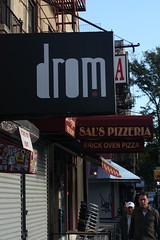 Joe Puglisi Drom, 85 Avenue A.
Joe Puglisi Drom, 85 Avenue A.Drom, the world music venue on Avenue A, is undergoing rebirth after several months closure.
The club exists down some stairs set back in a building between Fifth and Sixth Streets, so it’s easy to miss. The entryway, usually crowded with bar-hoppers, is gated during the day, with only a sign to indicate its location. Some may have assumed it had closed for good.
Drom was founded three years ago by Serdan Ilhan, a seasoned music producer from Istanbul. According to Mr. Ilhan, Drom started as a stage for “world music, especially gypsy music.” Gypsy style, originating with the Romani people of Eastern Europe but now a global phenomenon, is essentially a blend of European and Indian folk styles.
Mr. Ilhan has been involved in the music business since 1994, working with world music events at Lincoln Center and Summerstage. He has also toured with several acts. But operating a venue is his main passion. Drom is the third in a series of attempts to curate a stage in the East Village. “I’ve been in the business a long time,” Mr. Ilhan said. “And venue and the music are together for me.”
Read more…
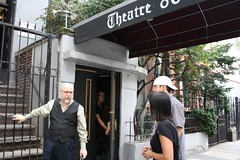 Maya Millett Lorcan Otway guides a tour of prohibition enthusiasts towards the gangster museum, located on the upper level of Theater 80.
Maya Millett Lorcan Otway guides a tour of prohibition enthusiasts towards the gangster museum, located on the upper level of Theater 80.Long before the Beat poets, the Warhol kids, free-spirited artists and musicians came to define the East Village’s bohemian scene, a different kind of character dominated the streets: the neighborhood bootlegger.
During the height of the 1920s Prohibition era, New York City served as the American gangster’s playground. Behind ordinary storefronts and in dingy back alleyways, men and women thirsty for forbidden libations and the prospect of a good time crept up to nondescript doors and slipped into another world. At the height of the Jazz Age, America was ready to dabble in debauchery even in the East Village, where European immigrant families crowded into tenement buildings.
Unlike the glamorous settings depicted on the new HBO series “Boardwalk Empire” the face of the speakeasy owner here was often not a wily gangster, but a German shopkeeper or a Jewish teacher. For these East Villagers, starting a speakeasy was as easy as opening their homes for an afternoon to sell alcohol. The illegal booze was snagged through a number of enterprising means — whether through dealings with a local bootlegger or grabbing what they could from a stalled truck transporting the stuff. “It was just kind of a buyer’s market — bootleggers were slipping menus underneath doors like Chinese food menus.”
Read more…



























